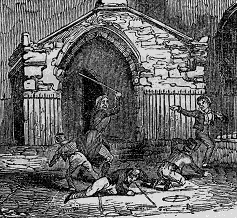 For a largescale digitisation project a carefully sequenced workflow is vital to its smooth running. Ideally a system rather like triage would pre-process the material sorting out duplicates and damaged items so that all conservation work was done on the objects before digitisation. The items would then be fed on to the cataloguer, who would pass them on to be scanned. This sequence conservation - cataloguing - digitisation did not prove viable however, for several reasons. The most obvious of these was time. Conservation work was fitted into an already busy general repair schedule (the project funding did not include additional conservation staff), so although most repair work was done quickly (such as preventative mending of tears around the edges of items) the short timescale of the project made it impossible to delay cataloguing. Repair, and ideally cleaning of every item would be desirable before digitisation, to give the best result: fortunately the lack of time for this compounded with other compromises dictated by the project, which was not going to be capable of providing a pristine copy of every item in any case, as this depended upon the state of the documents in the partners' collections.
For a largescale digitisation project a carefully sequenced workflow is vital to its smooth running. Ideally a system rather like triage would pre-process the material sorting out duplicates and damaged items so that all conservation work was done on the objects before digitisation. The items would then be fed on to the cataloguer, who would pass them on to be scanned. This sequence conservation - cataloguing - digitisation did not prove viable however, for several reasons. The most obvious of these was time. Conservation work was fitted into an already busy general repair schedule (the project funding did not include additional conservation staff), so although most repair work was done quickly (such as preventative mending of tears around the edges of items) the short timescale of the project made it impossible to delay cataloguing. Repair, and ideally cleaning of every item would be desirable before digitisation, to give the best result: fortunately the lack of time for this compounded with other compromises dictated by the project, which was not going to be capable of providing a pristine copy of every item in any case, as this depended upon the state of the documents in the partners' collections.With the additional danger of mixing up distinct collections in mind, it proved simplest to work through each partner's collection in turn. For scanning, loose items are easiest to process and so these were done first. For cataloguing, it makes more sense to start with the standard volumes of county history and the major sets of prints issued in bound form. This is a good introduction to the broad range of material for the cataloguer, and often includes the items that will reappear most frequently throughout the rest of the groups of loose items or albums. This approach will inevitably lead to some cases where a less perfect item is scanned, but should at least give the cataloguer a set of uncropped images to catalogue. As they are preserved in their context, they are also easier to catalogue quickly, as less research is required to date the items or speculate as to the possible context in which they were published. It will be necessary to revise catalogue descriptions in the light of other versions of the same print found subsequently, and possibly to re-scan a few items.
This approach will deal with loose items and albums or extra-illustrated volumes. There is however, no easy way to track down the many items that appear in books on the region, the country, or topics such as industry or social history. These will have to be added to the database as they are found, although some may be traced by selected browsing through likely subject categories.